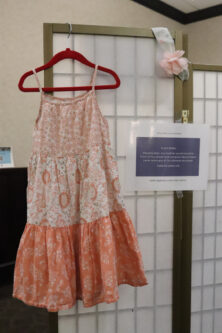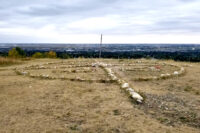Exhibit challenges rape myths
By Lethbridge Herald on October 20, 2023.
 Herald photo by Alejandra Pulido-Guzman
The Sexual Violence Action Committee's exhibit What Were You Wearing survivor art installation hopes to end rape culture myths by showcasing outfits inspired by what survivors were wearing when they were sexually assaulted.
Herald photo by Alejandra Pulido-Guzman
The Sexual Violence Action Committee's exhibit What Were You Wearing survivor art installation hopes to end rape culture myths by showcasing outfits inspired by what survivors were wearing when they were sexually assaulted.Alejandra Pulido-Guzman
LETHBRIDGE HERALD
The Sexual Violence Action Committee (SVAC) is inviting members of the community to visit their survivor art installation ‘What Were You Wearing’ today until 3 p.m. at the Sandman Hotel.
CEO of Chinook Sexual Assault Centre and Co-chair of SVAC, Kristine Cassie told media Thursday SVAC is a committee in which members of multiple organizations join forces to find ways to better help victims of sexual assault in the community.
“Players from all sorts of agencies including our post-secondary institutions, other helping services like Lethbridge Family Services, the YMCA, YWCA, Chinook Sexual Assault Centre and the school districts. We come together to talk about how our systems can work better together, how we work alongside with police to actually support victims, because we know so few go forward to the police to actually make those reports,” said Cassie.
She said they decided to put this art installation up so it will challenge those in attendance to engage with the universal connection we have with clothing, and reflect on what gives this specific rape culture myth so much power.
What Were You Wearing, is a survivor art installation that asks participants to understand it was never about the clothing that caused the sexual assault. It originated at the University of Arkansas in 2013. Created by Jen Brockman and Mary Wyandt-Hiebert, the project was inspired by Mary Simmerling’s poem, What I Was Wearing.
“This is a time to come and look at the survivor art installation and really take some reflection on what is feeding our beliefs around sexual violence in our communities, and what actions can we take to actually counter that,” said Cassie.
“This is a time to come and look at the survivor art installation and really take some reflection on what is feeding our beliefs around sexual violence in our communities, and what actions can we take to actually counter that,” she added.
Cassie said during the exhibit there are resources available from multiple agencies that are involved with sexual assault victims, to assist anyone interested in learning more on how to support someone who has been a victim of sexual assault, victims themselves, or for anyone who is triggered by the exhibit while visiting.
Cassie said the exhibit also calls out other rape myths like men cannot be raped by women, being alone with someone the victim trusts, and being around people the victim’s parents trusted to be around them, among others.
When it comes to the installation itself, co-chair of SVAC and community domestic violence response lead from Lethbridge Family Services, Tracy Rocca told media Thursday they hope people take the time to read through the survivors’ stories, and take a look at the clothes that represent similar choices worn by the survivors.
“I hope people are moved and they see it in a new perspective. The idea is to dispel rape myths and I encourage everyone to have a look at the poem ‘What I was wearing’ as it’s a powerful poem and I think the point is that if we could only end rape by changing our clothes, if it was only that simple,” said Rocca.
She said the exhibit is based on survivors from Lethbridge and surrounding area, and they try to have a variety of clothing choices, age ranges and both male and female survivor stories.
“There are some powerful ones. The lifeguard talks about ‘I didn’t think men could be raped’ or ‘I was told men couldn’t be raped.’ We also have some cultural representation, and we have different age range to, we have a young girl’s dress and some university student outfits,” said Rocca.
Next to the little girl dress the description reads, “A sun dress. Months later, my mother would stand in front of my closet and complain about how I never wore any of my dresses anymore. I was six years old. (Outfit inspired by a university student).”
Next to the lifeguard outfit Rocca mentioned, the description reads, “My lifeguard uniform. She said ‘guys can’t be raped.’ She didn’t stop. (Outfit inspired by an university student).”
Next to one of the cultural representation outfit Rocca mentioned, the description reads, “I was wearing a sari, the same thing I wear most days. It was what I was comfortable in. It reminded me of home, of my family, of my identity. Now it reminds me of him. (Outfit inspired by university graduate)”
Other descriptions include survivors of multiple sexual assaults, sexually assaulted by family members, by trusted family friends, and someone wearing a long skirt and thinking she was safe because she did not wear “those type of skirts.”
A description from a survivor who is now a retail manager that is not attached to a represented outfit, but among other descriptions reads, “My favourite yellow shirt, but I don’t remember what pants I was wearing. I remember being so confused and just wanting to leave my brother’s room and go back to watching my cartoons.”
Cassie explained that clothing choices and the idea of getting asked about what they were erasing, not only puts the blame on the victim, but in many cases it stops people from coming forward with information as they worry about being blamed for their clothing choices and not the perpetrator.
“We’ve done a great job over the centuries of putting that blame on the victim rather than flipping it and saying this actually belongs with the perpetrator. That keeps people from coming forward to report violations that have happened to them, so if we can flip that, maybe we can hear more of what’s going on, maybe we can call people out from the shadows that are those perpetrators, call them out and actually hold them accountable,” said Cassie.
The What Were You Wearing art installation will conclude its two-day- exhibit today from 9 a.m. to p.m. at the Sandman Hotel located at 421 Mayor Magrath Drive South.
23-22




